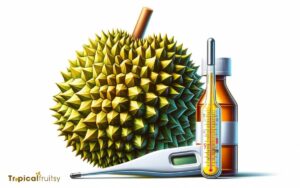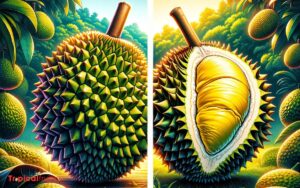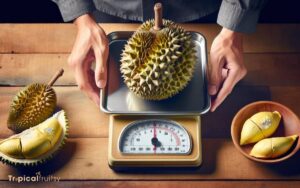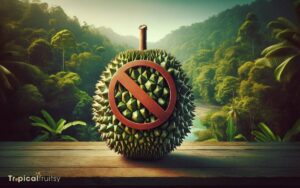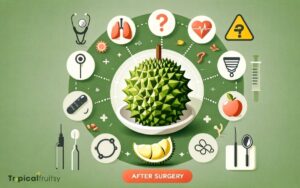Why Does Durian Smell So Bad? Explained!
Durians have a potent smell often described as a combination of rotten onions, turpentine, and raw sewage. This strong odor is due to a mix of volatile sulfur compounds, esters, and ketones produced as the fruit ripens.
The smell of durian is notorious, and while some people find it pleasant, many others are repelled by its pungency.
The compounds responsible for the smell serve several purposes:
The odor of durian is a natural part of the fruit’s ripening process and serves to attract certain animals to eat the fruit and disperse its seeds. However, this same smell makes it banned in many public spaces in Southeast Asia.
While durian’s smell is divisive, it’s a culinary delicacy in many cultures, highlighting how sensory perceptions can dramatically vary from person to person.
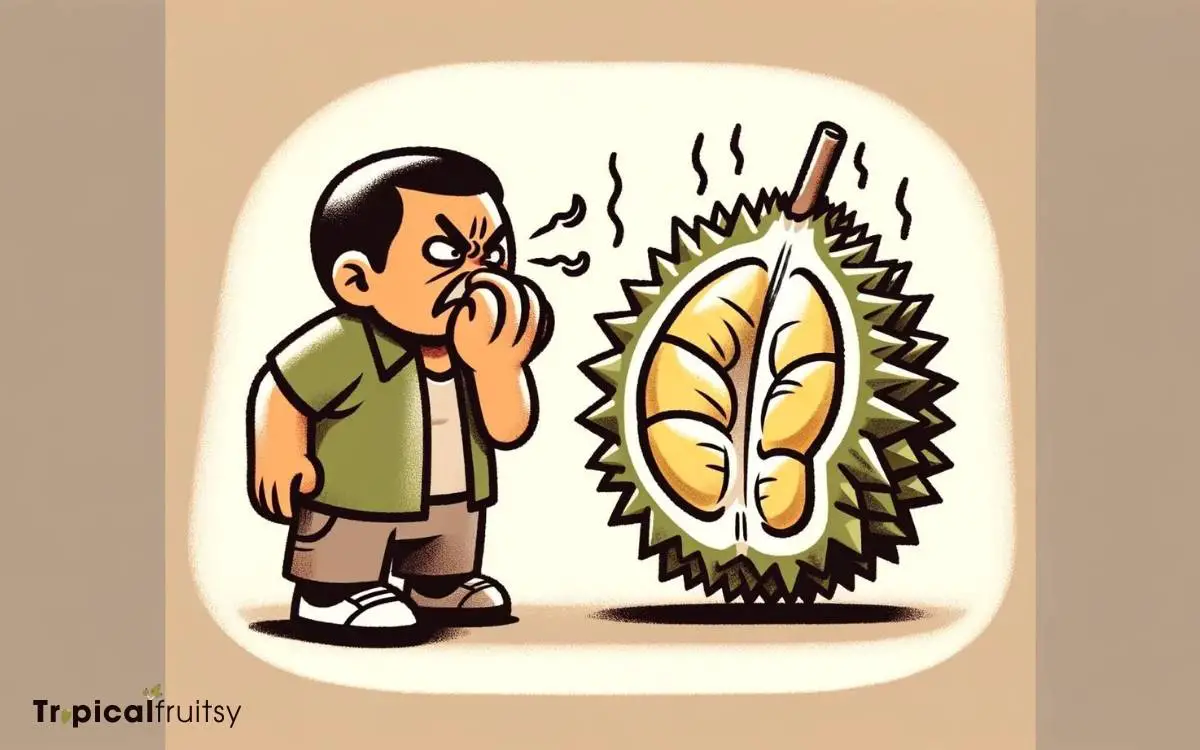
Key Takeaway
Understanding Durian’s Pungent Smell: A Chemical Perspective
| Compound | Description | Role in Durian Odor |
|---|---|---|
| Ethanethiol | A volatile sulfur compound. | Contributes to the strong, pungent odor. |
| Methionine gamma-lyases | Enzyme that produces sulfur compounds. | Involved in the release of sulfuric aromas during ripening. |
| Other volatile compounds | Various other sulfur-rich compounds. | Add complexity to the durian’s distinctive smell. |
| Genetic factors | Variations in durian species. | Influence the intensity and quality of the odor. |
| Ripeness | Stage of fruit maturity. | Affects the strength of the durian’s smell. |
| Cultural background | Exposure and familiarity with the fruit. | Shapes individual perception and acceptance of the odor. |
The Chemical Composition of Durian
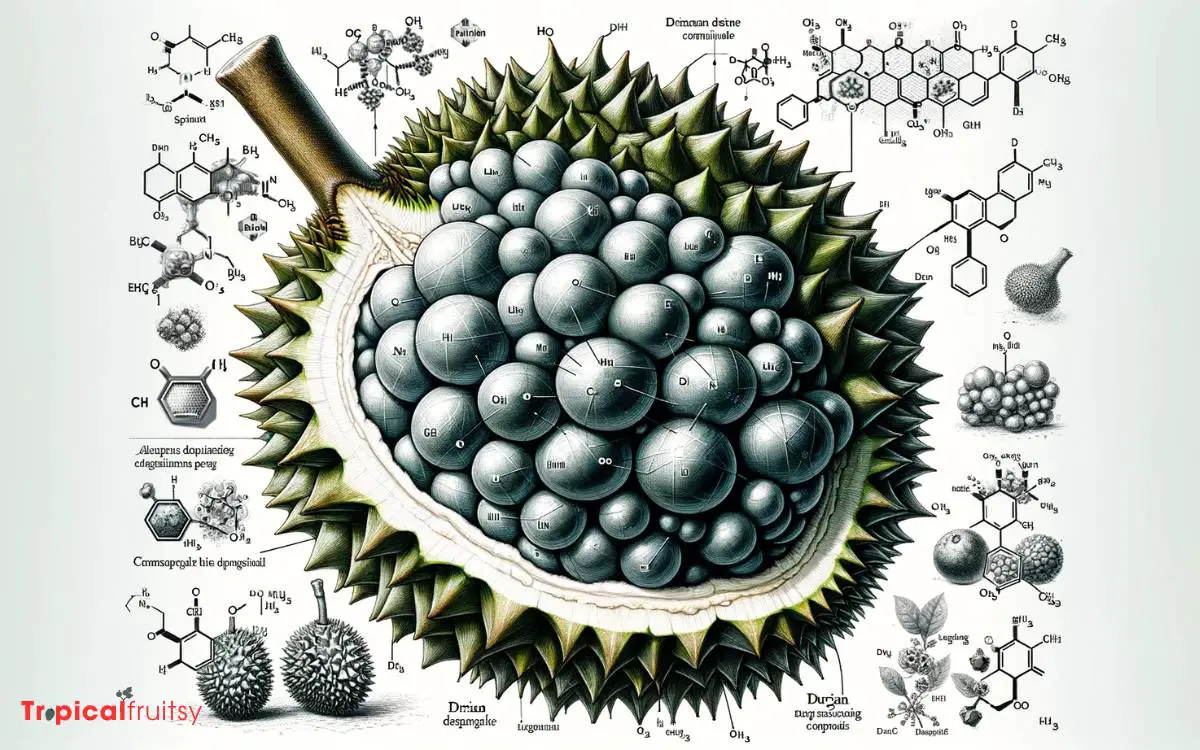
The chemical composition of durian fruit is complex, comprising a multitude of volatile compounds that contribute to its notorious and pungent odor.
Scientific analysis reveals that the odoriferous profile of durian is due to esters, ketones, alcohols, and sulphur-containing compounds, such as thiols, thioesters, and polysulfides.
These sulfuric elements are particularly influential, generating aromas likened to rotting onions, raw sewage, and other unpleasant scents when present in certain concentrations and combinations.
The precise balance of these substances varies among different durian cultivars, which explains the range of odors observed across various types of the fruit.
Understanding the specific molecular interactions and the enzymatic pathways responsible for the biosynthesis of these compounds is essential for a comprehensive grasp of the durian’s olfactory impact.
The Role of Sulfur Compounds
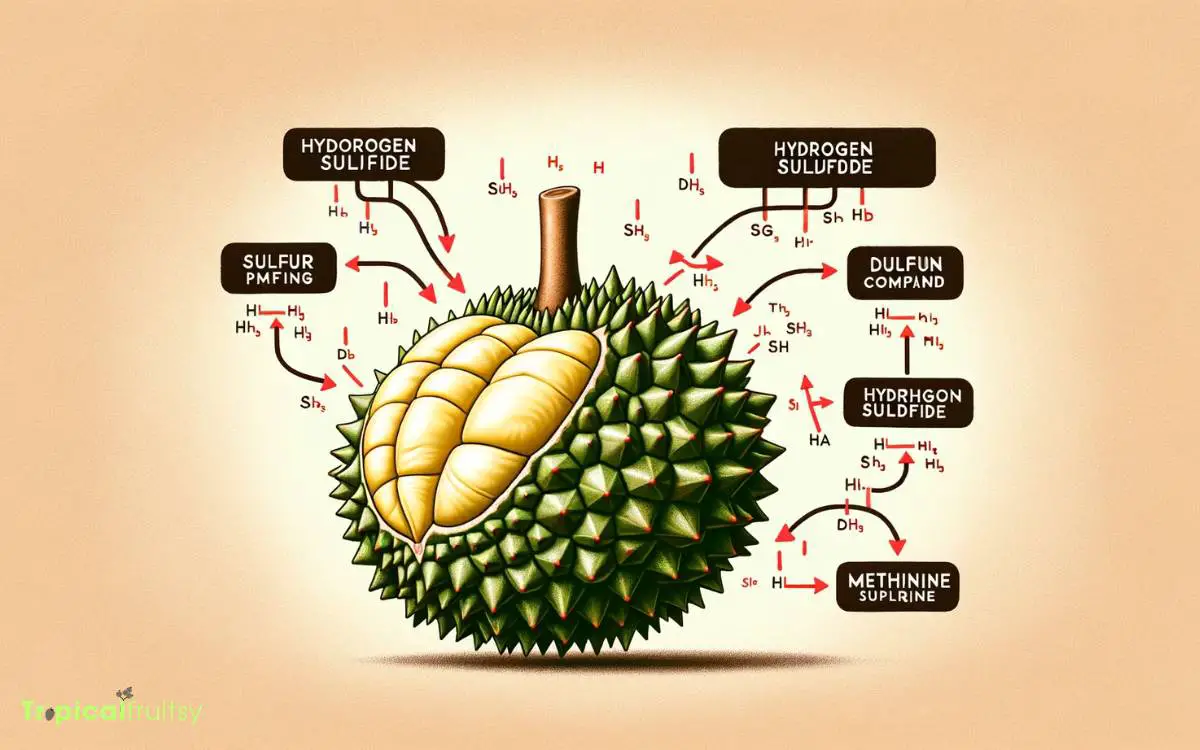
Sulfur compounds are identified as primary contributors to the pungent odor characteristic of durian fruit.
An examination of the correlation between the presence of these compounds and the intensity of the smell can provide insights into the mechanisms of odor production.
Advanced chemical analysis techniques enable the identification and quantification of these sulfur-containing molecules, furthering our understanding of their role in the fruit’s distinctive aroma.
Sulfur Compounds Presence
In durian fruit, volatile sulfur compounds are primarily responsible for its notoriously pungent odor.
These compounds include a variety of sulfur-bearing constituents, such as thiols, thioesters, and polysulfides, which are biochemically synthesized in the fruit.
Scientific analysis reveals that the presence and concentration of these sulfur compounds correlate significantly with the intensity of the durian’s smell.
Their molecular structure allows for a high volatility, which means they readily vaporize at room temperature and infuse the air with the fruit’s characteristic aroma.
The enzymatic reactions leading to the creation of these compounds are also influenced by the fruit’s ripeness, resulting in an intensified smell as the durian matures.
Understanding the role and presence of these sulfur compounds is key to comprehending the durian’s unique and powerful scent profile.
Smell Intensity Factors
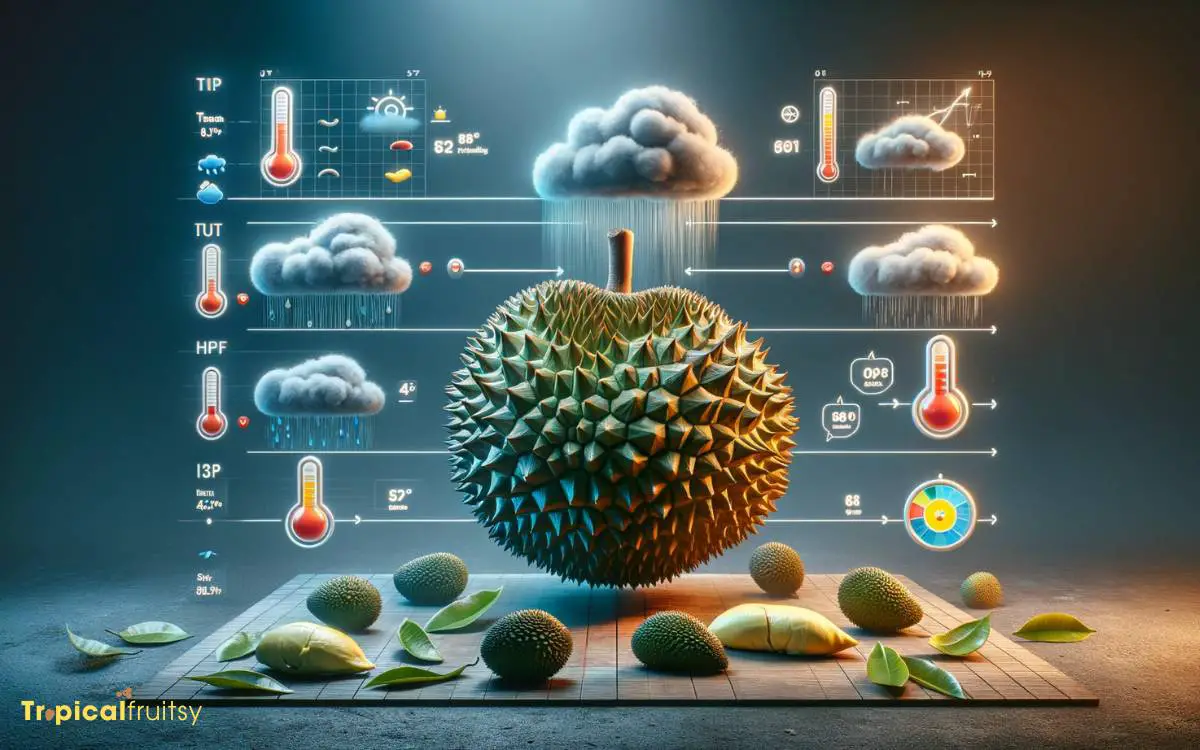
Durian’s offensive odor intensifies due to the concentration and activity of sulfur compounds within the fruit.
These volatile compounds, including hydrogen sulfide, methanethiol, and dimethyl sulfide, are responsible for the potent aroma that many find unpleasant.
Their molecular structure facilitates a rapid release into the air, allowing the scent to be detected at low thresholds.
The intensity of the smell can vary due to factors such as the durian’s ripeness, environmental conditions, and genetic variations between different species.
During ripening, enzymatic reactions increase the release of odoriferous sulfur compounds, enhancing the fruit’s pungency.
Storage conditions, such as temperature and humidity, can also affect the volatility and perception of these compounds, thereby modulating the fruit’s overall olfactory impact.
Odor Chemical Analysis
Delving into the chemical composition of durian odor, researchers have identified a complex array of sulfur-based compounds as the primary culprits behind its notoriously strong scent.
These volatile sulfur compounds (VSCs), including hydrogen sulfide, methanethiol, and dimethyl sulfide, are produced during the fruit’s ripening process.
Advanced gas chromatography-mass spectrometry analysis has revealed that these compounds are present in higher concentrations in durian than in most other fruits, contributing to its powerful and persistent smell.
The technical scrutiny of these compounds shows that even at low concentrations, they have a high odor activity value (OAV), meaning they are highly detectable to the human nose.
This insight leads to the exploration of the evolutionary reasons behind durian’s potent aroma, particularly the theory of it serving as a defense mechanism.
Durian’s Defense Mechanism Theory
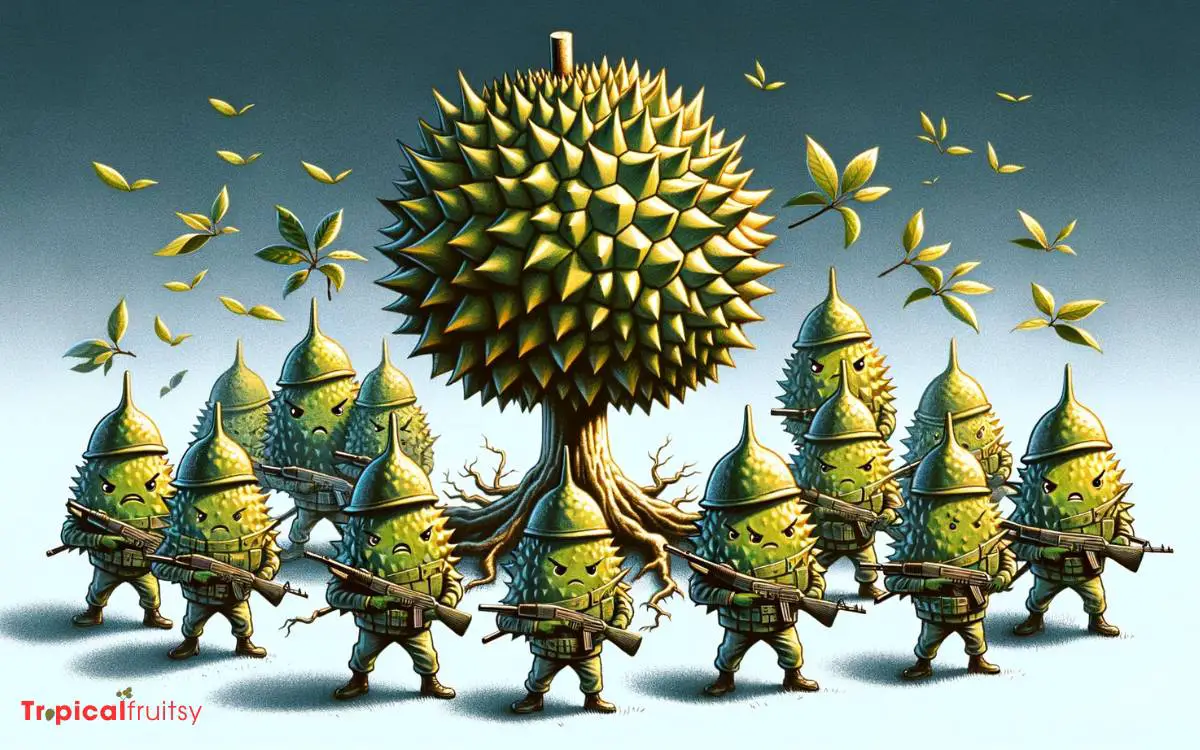
The pungent aroma of durian is hypothesized to serve as a defense mechanism, deterring potential predators through the emission of intense odors.
Concurrently, this distinctive smell may play a dual role by attracting specific pollinators essential for the plant’s reproduction.
The theory suggests that the survival of durian species may be intricately linked to the development of their characteristic scent profile as a means of ecological adaptation.
Predator Repellent Strategy
Despite emanating an odor that many humans find unpleasant, the durian fruit’s potent smell is thought to function as a natural deterrent against certain predators, serving as an evolutionary defense mechanism.
The hypothesis suggests that the unique olfactory characteristic of durian may have evolved to repel animals that could harm the fruit or be ineffective at dispersing its seeds.
The following points highlight the strategic aspects of durian’s odor:
- Selective Repulsion: Targets specific predators, potentially deterring those likely to crush or consume the seeds without facilitating their dispersal.
- Seed Protection: Strong smell masks the scent of the seeds, making them less detectable and desirable to animals.
- Species Continuation: Promotes seed dispersal by attracting certain species, ensuring propagation of the durian tree.
The analysis of durian’s smell as a predator repellent strategy reflects a sophisticated adaptation, potentially contributing to the fruit’s survival and proliferation.
Aroma Attracts Pollinators

While its odor repels certain predators, the durian fruit’s aroma plays a crucial role in attracting pollinators, which is essential for the plant’s reproductive success.
The malodorous scent is an evolutionary adaptation that specifically targets a group of pollinators that have a preference for strong, pungent odors as signals for potential food sources.
These pollinators, primarily certain bat species and insects such as beetles, are drawn to the durian’s intense smell, thereby facilitating the process of pollination.
The biochemical basis for this olfactory signal involves volatile sulfur compounds that are highly effective at dispersing through the air, even across significant distances, thus maximizing the reach to attract the intended pollinators while simultaneously deterring organisms that may pose a threat to the fruit’s integrity.
Survival Through Odor
Moving beyond attraction, durian’s pungent odor also serves as a sophisticated defense mechanism, warding off herbivores that might otherwise consume the fruit before it can be properly pollinated and dispersed.
The distinctive smell of durian is due to a combination of volatile compounds that are released as the fruit matures.
These compounds have been shown to have a deterrent effect on certain animals, effectively reducing the risk of premature consumption.
This selective repulsion ensures that only specific dispersers, such as particular species of bats and birds, which are unaffected by the odor, can access the fruit.
Key points of the defense mechanism include:
- Selective deterrence: Targets specific herbivores while allowing effective dispersers to interact with the fruit.
- Chemical complexity: A blend of compounds contributes to the strong odor, which is a multifaceted deterrent.
- Evolutionary advantage: The smell increases the likelihood of seed dispersal by appropriate vectors, enhancing reproductive success.
Genetic Factors in Durian Varieties
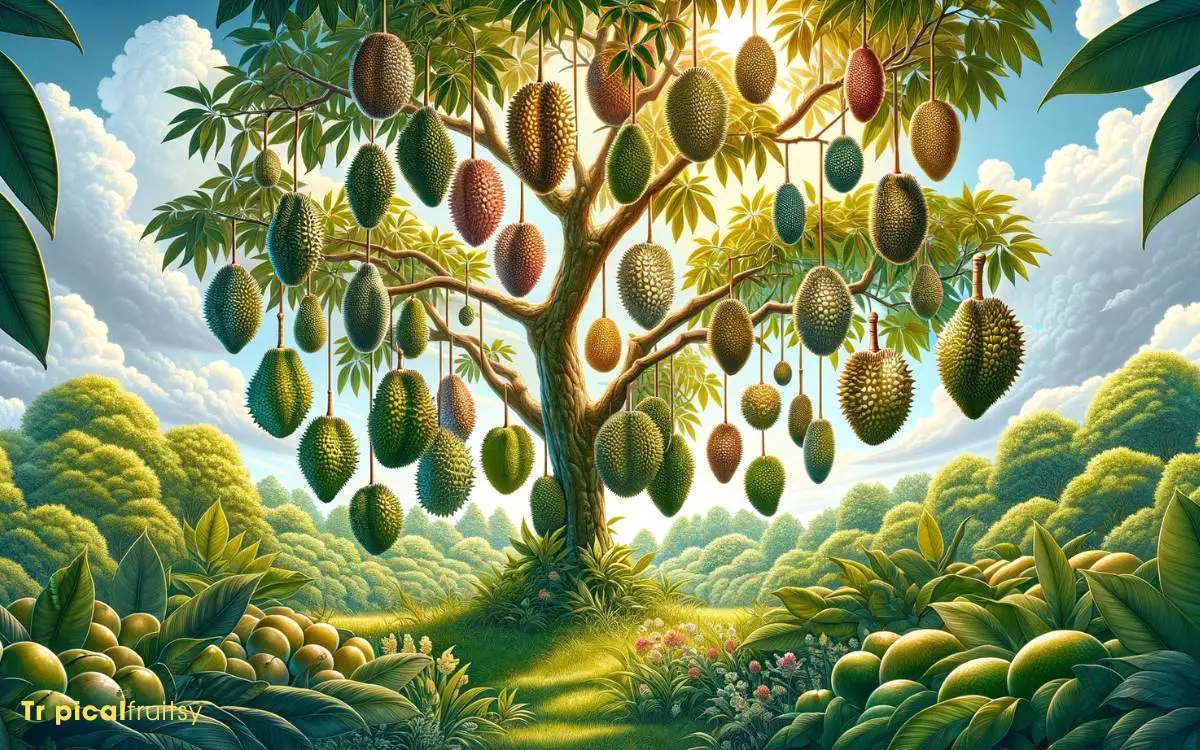
Genetic variations among durian species play a critical role in the intensity and composition of the fruit’s notorious odor.
Recent genomic studies have identified a plethora of volatile compounds that contribute to the durian’s distinctive smell, which not only varies in degree but also in character among different cultivars.
These genetic differences affect the expression of enzymes involved in the biosynthesis of key odor-active compounds, such as sulfides, esters, and ketones.
The biochemical pathways leading to these compounds are complex and are influenced by the genetic makeup of each variety.
Consequently, breeding and selection efforts have the potential to modulate these olfactory profiles, giving rise to cultivars with modified aromatic qualities.
Understanding the genetic underpinnings is essential for both the cultivation of less pungent varieties and the conservation of durian biodiversity.
The Impact of Ripeness on Odor
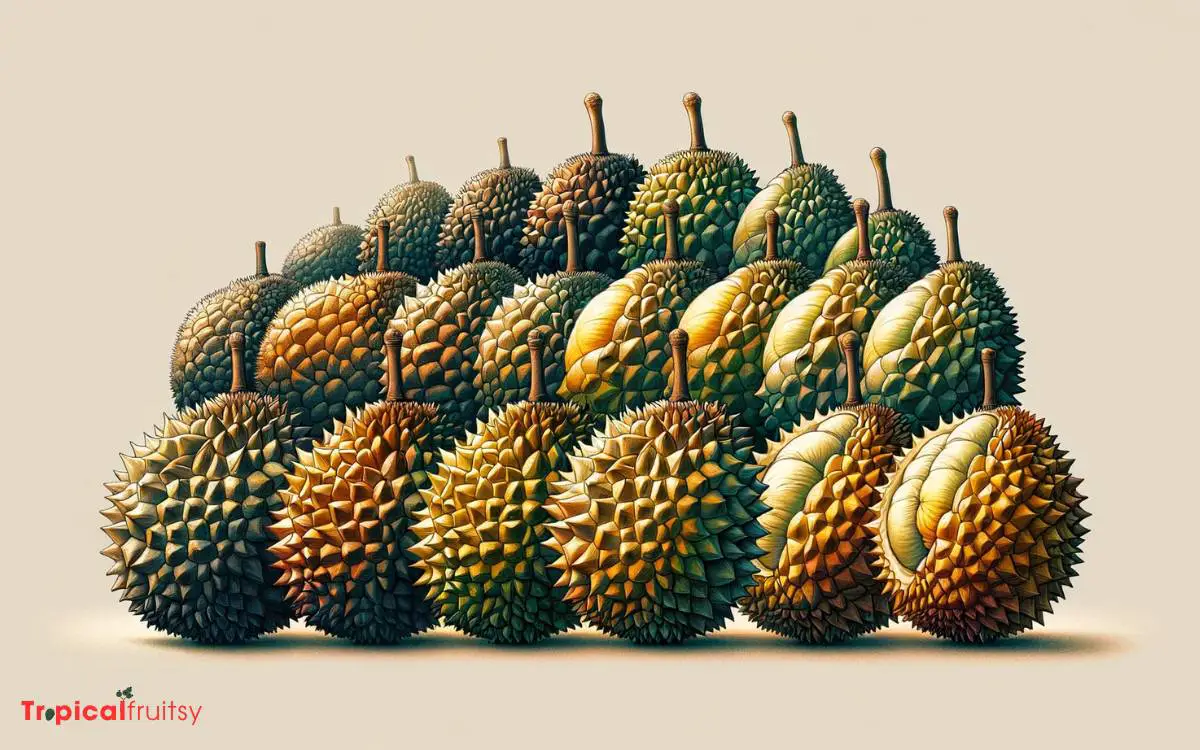
The degree of ripeness significantly influences the intensity of the durian’s malodorous scent, with a fully ripe fruit often emitting a stronger and more pungent aroma.
As the durian matures, biochemical reactions within the fruit escalate, leading to the production of volatile sulfur compounds that are key contributors to its notorious smell.
- Enhanced enzymatic activities break down amino acids, increasing the emission of foul-smelling gases.
- Ethylene production, signaling the ripening process, further intensifies the odor profile.
- Sulphide compounds peak in concentration, amplifying the sensory impact on individuals.
Through scientific analysis of these processes, it’s understood that ripeness is a critical determinant in the intensity of durian odor, affecting both the immediate environment and human perception.
This biological phenomenon segues into the varying cultural perceptions of durian scent, a subject of considerable interest and debate.
Cultural Perceptions of Durian Scent
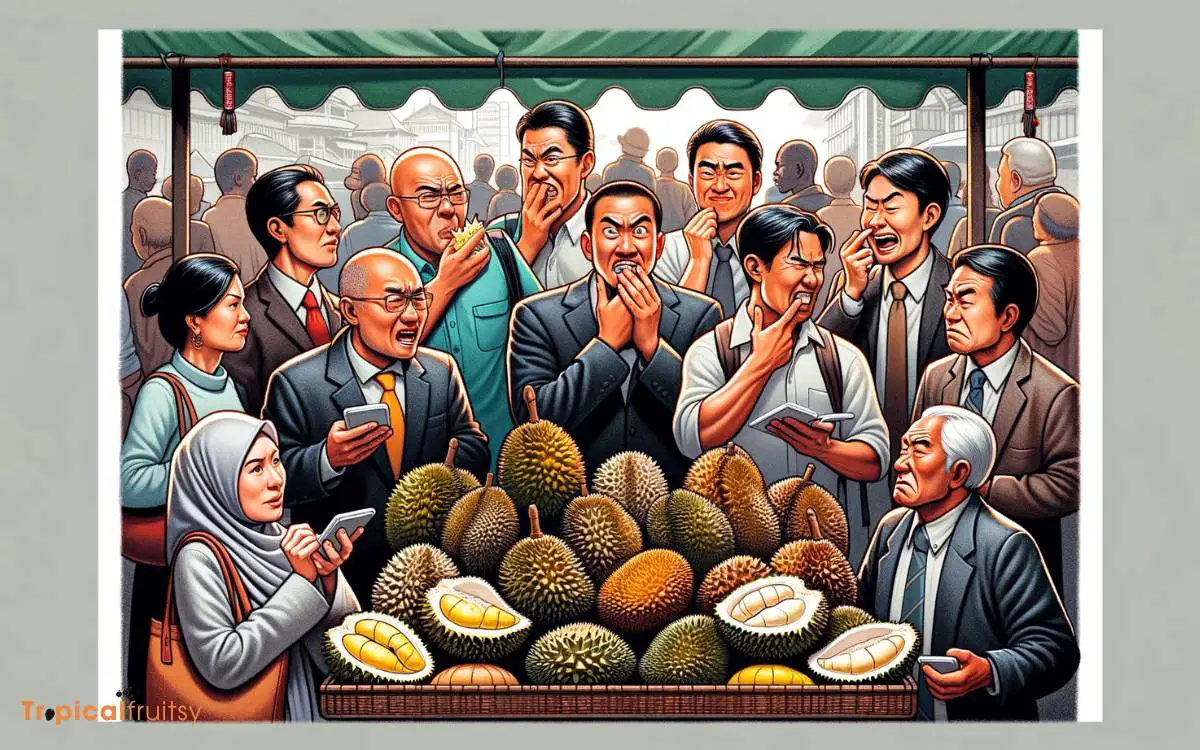
In light of varying global cultures, the durian’s pungent scent is met with a spectrum of reactions, ranging from deep appreciation to intense aversion.
This dichotomy in perception is not merely anecdotal; it is substantiated by social and psychological studies.
Regions where durian is endemic, particularly in Southeast Asia, have populations that often regard the fruit’s odor as pleasantly sweet, attributing positive descriptors such as ‘rich’ or ‘almond-like.’
Conversely, individuals with less exposure to the fruit, particularly in Western cultures, frequently describe the smell as overpowering and reminiscent of rotten onions or sewage.
This divergence is likely a consequence of diverse dietary customs, exposure, and perhaps an element of acquired tolerance or preference, illustrating a compelling case of olfactory perception’s intersection with cultural context.
Comparing Durian to Other Foods

Durian’s distinctive aroma sets it apart from other foods, which typically lack the complex combination of volatile compounds responsible for its infamous smell.
This fruit’s unique scent profile can be attributed to the presence of over 50 different compounds, some of which are found in other foods but not in the same concentration or combination.
When comparing durian to other odorous foods, it’s important to consider:
- The intensity of the aroma, which is much stronger in durian than in most other foods.
- The diverse range of smells, from sweet and fruity to skunky and onion-like, that are rarely found together in other food items.
- The persistence of the scent, which can linger and permeate through spaces more aggressively than other food-related odors.
In an analytical context, these factors contribute to the polarizing nature of durian’s olfactory impact.
Acclimatization to Durian Aroma
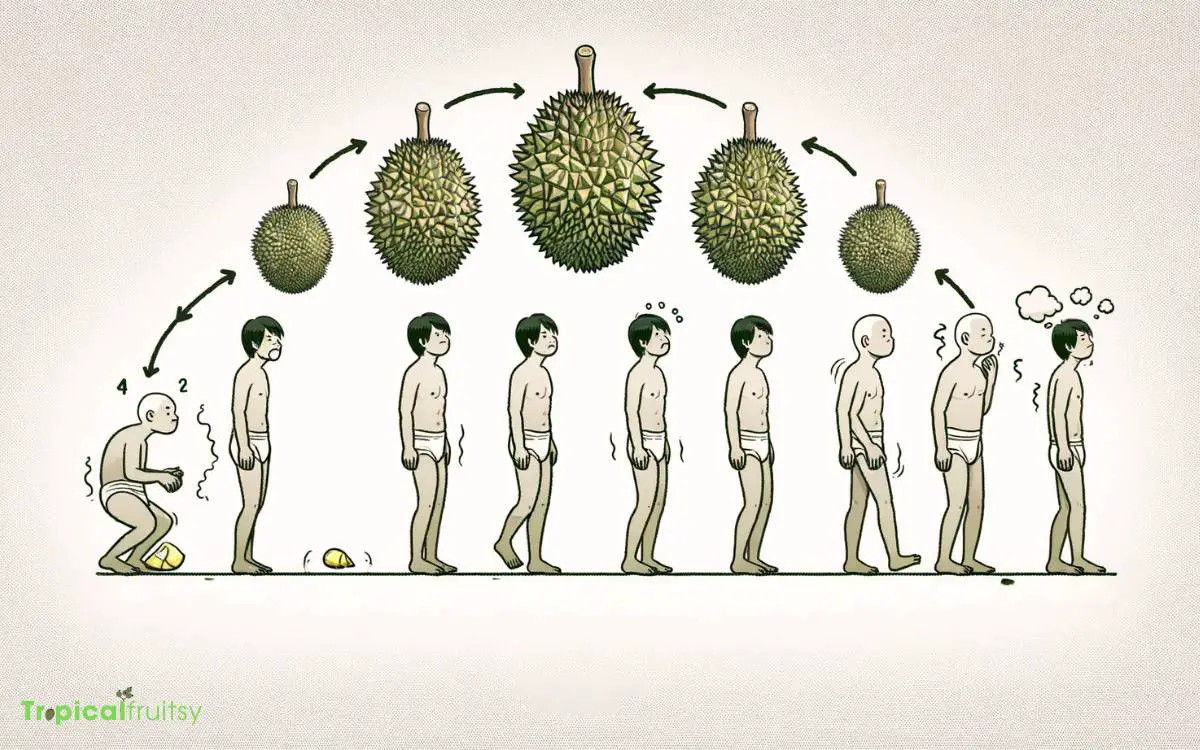
Despite its notorious reputation, regular exposure to durian’s pungent aroma can lead to acclimatization, with individuals becoming less sensitive to its smell over time.
This phenomenon is akin to olfactory adaptation, where sensory receptors in the nose become less responsive to persistent stimuli.
Research suggests that olfactory receptors, upon repeated and prolonged exposure to a specific odorant, may experience a temporary decrease in sensitivity, thereby reducing the perceived intensity of the odor.
This physiological adaptation can result in a diminished olfactory response, enabling individuals to tolerate, and even appreciate, the complex flavor profile of durian that lies beneath its initial olfactory offense.
Thus, acclimatization to durian’s aroma may serve as a gateway to its acceptance and enjoyment, particularly in cultures where it is revered as a delicacy.
Why Does Durian Smell Bad but Taste Good
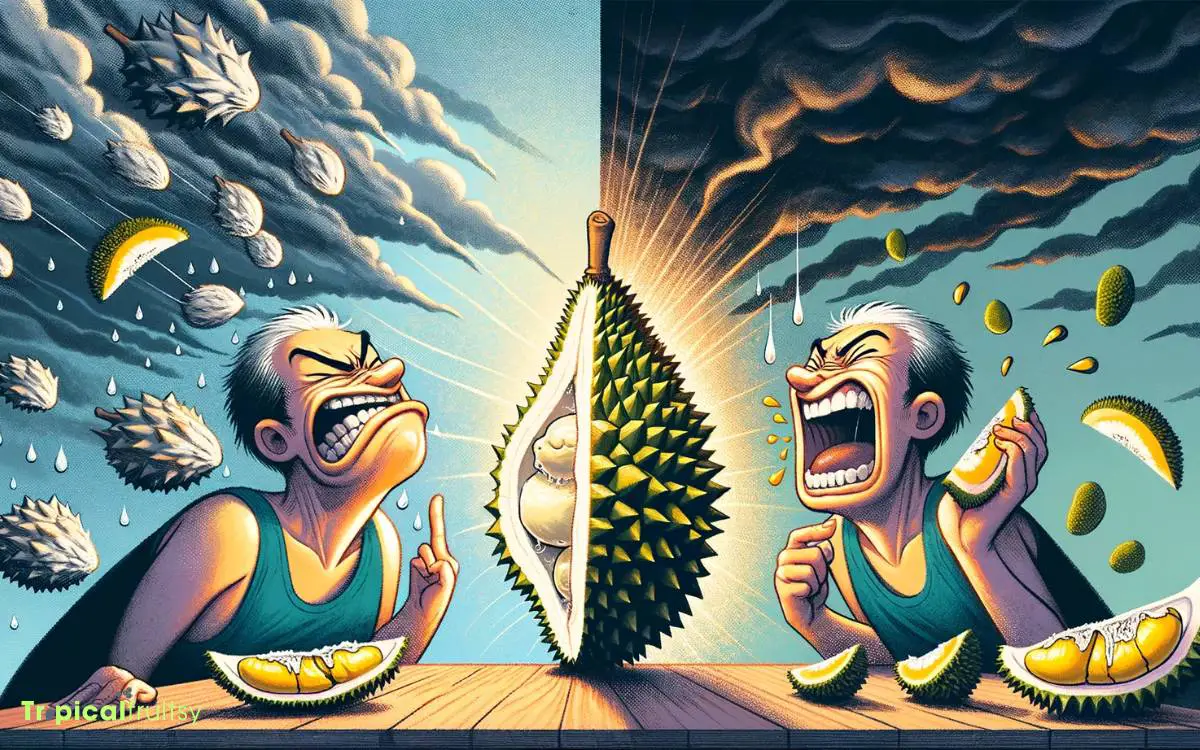
Durian’s notorious smell and delicious taste are the result of its complex chemistry, which has intrigued both enthusiasts and researchers alike.
The “bad” smell, often compared to rotten onions, sewage, or turpentine, contrasts sharply with its rich, creamy texture and sweet, almond-like flavor that many people love.
Here’s why durian has this peculiar combination:
Sulfur Compounds: Durian contains high levels of volatile sulfur compounds, which are primarily responsible for its strong odor.
These compounds, including hydrogen sulfide, methanethiol, and ethanethiol, are also found in rotten eggs and onions, contributing to the fruit’s pungent smell.
The presence of these compounds is a natural part of the fruit’s defense mechanism, possibly deterring animals from eating the fruit before it’s ripe enough for its seeds to be dispersed effectively.
Esters and Ketones: Besides sulfur compounds, durian also contains esters and ketones, which contribute to its complex aroma profile.
These chemical compounds can produce fruity, sweet, roasty, and caramel-like aromas that are more noticeable when eating the fruit, balancing out the initial pungent smell.
Genetic and Environmental Factors: The specific aroma and taste profiles of durian can vary significantly between different varieties and even among fruits from the same tree.
These differences are influenced by genetic factors and environmental conditions such as soil type, climate, and cultivation practices. Some varieties are bred for a less overpowering smell while maintaining the desirable taste qualities.
Subjective Perception: People’s perceptions of taste and smell are highly subjective and can be influenced by cultural background, individual sensitivity to certain compounds, and prior experiences with the fruit.
For those accustomed to durian, the smell may be associated with the pleasant taste that follows, leading to a positive overall experience.
Contrast and Complexity: The contrast between the durian’s smell and its taste may actually enhance the eating experience for some.
The complexity of its aroma, combined with the sweet and creamy flavor, offers a multi-sensory experience that is unique to durian, making it a delicacy for those who appreciate its depth and richness.
The dichotomy between durian’s smell and taste is a fascinating example of how complex chemical compositions can influence our sensory perceptions, leading to diverse and polarized opinions about this iconic fruit.
Does Durian Smell Bad to Everyone
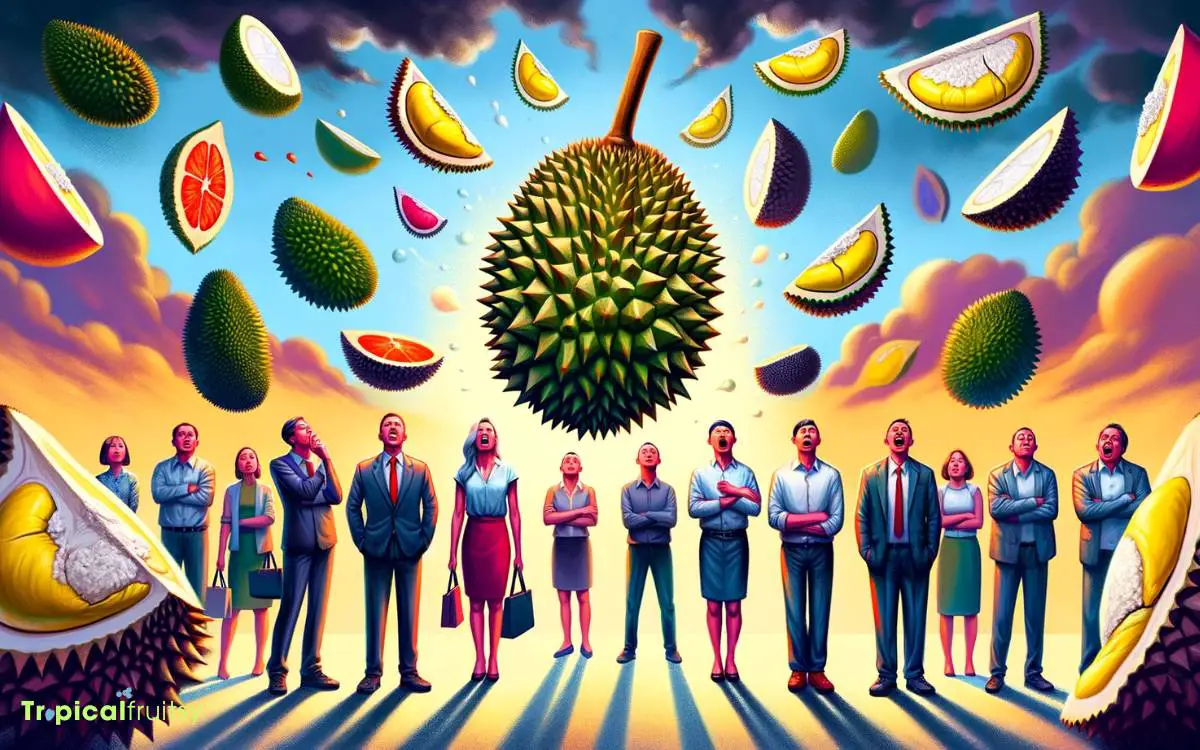
Durian’s smell does not universally register as bad to everyone, but it is indeed polarizing. The perception of durian’s aroma varies greatly among individuals, influenced by cultural background, personal experience, and even genetic makeup.
To some, durian smells pleasantly sweet and enticing, while others find the odor overpowering and unpleasant, likening it to rotten onions, raw sewage, or other disagreeable scents.
Several factors contribute to this wide range of reactions:
Cultural Familiarity: In cultures where durian is commonly consumed, such as in Southeast Asia, people are more likely to grow up exposed to its smell and associate it with positive experiences, such as family gatherings or festive occasions.
This familiarity can make the smell more acceptable or even enjoyable.
Genetic Factors: Just as with cilantro, where some people have a genetic predisposition to perceive the herb as tasting like soap, genetic variations can also influence how individuals perceive the smell of durian.
Research has identified certain genes that affect how we perceive odors, which means the durian’s smell could be more or less intense to different people based on their genetic makeup.
Expectation and Perception: The psychological aspect of expectation can also play a role. If someone is told to expect a foul odor, they might be more likely to perceive it as such.
Conversely, if they approach durian with an open mind or with positive anticipation, they may find the aroma less offensive or even appealing.
Chemical Composition: Durian contains a complex mix of volatile compounds that contribute to its distinctive smell.
These include esters, ketones, and alcohols, which can produce aromas reminiscent of fruits, cheese, caramel, and onion among others.
The combination of these compounds can trigger different responses in people, making the fruit smell delicious to some and repulsive to others.
In summary, while durian’s smell is often described as bad, this perception is not universal.
Cultural background, personal experiences, genetic factors, and individual expectations all play significant roles in determining one’s reaction to the smell of durian.
Conclusion
The notorious olfactory profile of durian fruit is a tapestry woven with complex biochemical strands, including sulfur compounds and varying genetic expressions.
While this aroma serves as a natural defense mechanism and a ripeness indicator, it also stands as a divisive cultural hallmark.
Ironically, what some describe as an unbearable stench is considered by others a fragrant delicacy, reflecting the paradoxical nature of human olfaction and taste – an enigma encapsulated in a spiky husk.

